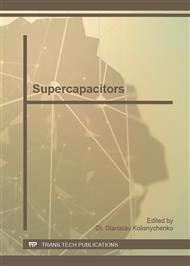p.520
p.525
p.529
p.534
p.539
p.545
p.550
p.555
p.563
Thermal Analysis on Symmetric Rectangular Stackable Supercapacitors
Abstract:
In this paper, thermal model of the symmetric rectangular stackable supercapacitors are established. By using the finite element method, the temperature distribution of the supercapacitor is simulated. Then the supercapacitor's thermal behavior under the ambient temperature, but with different current density is analyzed. The simulation results show that the maximum temperature during the discharge process occurs in the center of the supercapacitor. The maximum temperature is associated with the applied current, and the higher the applied current is, the higher the maximum temperature is. It's necessary to control the maximum temperature within the allowable values, by establishing reasonable thermal management systems and cooling systems.
Info:
Periodical:
Pages:
539-542
Citation:
Online since:
March 2015
Authors:
Price:
Сopyright:
© 2015 Trans Tech Publications Ltd. All Rights Reserved
Share:
Citation:



